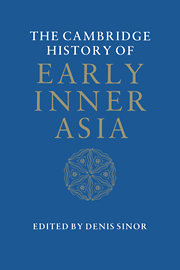Book contents
- Frontmatter
- 1 Introduction: the concept of Inner Asia
- 2 The geographic setting
- 3 Inner Asia at the dawn of history
- 4 The Scythians and Sarmatians
- 5 The Hsiung-nu
- 6 Indo-Europeans in Inner Asia
- 7 The Hun period
- 8 The Avars
- 9 The peoples of the Russian forest belt
- 10 The peoples of the south Russian steppes
- 11 The establishment and dissolution of the Türk empire
- 12 The Uighurs
- 13 The Karakhanids and early Islam
- 14 Early and medieval Tibet
- 15 The forest peoples of Manchuria: Kitans and Jurchens
- Bibliography
- Index
- References
1 - Introduction: the concept of Inner Asia
Published online by Cambridge University Press: 28 March 2008
- Frontmatter
- 1 Introduction: the concept of Inner Asia
- 2 The geographic setting
- 3 Inner Asia at the dawn of history
- 4 The Scythians and Sarmatians
- 5 The Hsiung-nu
- 6 Indo-Europeans in Inner Asia
- 7 The Hun period
- 8 The Avars
- 9 The peoples of the Russian forest belt
- 10 The peoples of the south Russian steppes
- 11 The establishment and dissolution of the Türk empire
- 12 The Uighurs
- 13 The Karakhanids and early Islam
- 14 Early and medieval Tibet
- 15 The forest peoples of Manchuria: Kitans and Jurchens
- Bibliography
- Index
- References
Summary
Unless they coincide with clearly defined physical boundaries – as is the case, for instance, with Australia – the borders of a cultural area can rarely be established with ease and accuracy. To some extent the problem lies with the highly subjective and often purely emotional criteria by which a civilization is defined. Thus, for example, as these lines are written, many nations would place themselves within a larger community which they call the “free world,” while no attempt is made to define what freedom may mean to human beings with a cultural background different from their own. If there is a “free world” then, presumably, there must exist, in the minds of those who use the term, another world, “not free,” and the differentiation is contingent on an emotionally charged interpretation of the ill-defined term of “freedom.” It is a well-known rule of logic that classifications made on the basis of a single attribute are artificial and of limited use. So there must be a cluster of attributes by which a human group is defined, and these must be specific and essential, if they are to serve a useful purpose. Yet what is essential to one observer is not to another. Some would opt for language, others for race, religion, or shared destiny in the past or the present. It is also quite common to find that individuals tend to identify their own community by criteria which may be different from those used for the same purpose by outsiders.
- Type
- Chapter
- Information
- The Cambridge History of Early Inner Asia , pp. 1 - 18Publisher: Cambridge University PressPrint publication year: 1990
References
- 8
- Cited by



